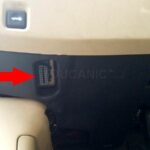Experiencing a rough idle or decreased engine performance in your 2013 Ford C-Max Hybrid? You might be facing an OBD2 code P0301, indicating a cylinder 1 misfire. While a P0301 code alone specifies a misfire in cylinder 1, it’s often related to the more general P0300 code, which signals random or multiple cylinder misfires. Understanding the root causes and proper diagnostic steps is crucial to getting your C-Max Hybrid back to running smoothly.
Common Causes of P0301 and P0300 in Your Ford C-Max Hybrid
While the P0300 code points to a general misfire, P0301 narrows it down to cylinder 1. Many of the underlying issues can trigger either code. For your 2013 Ford C-Max Hybrid, potential culprits for a P0301 or related P0300 code include:
- Worn Spark Plugs: Spark plugs are essential for igniting the air-fuel mixture. Over time, they wear down, leading to weak spark and misfires, a frequent cause in hybrid vehicles as well.
- Faulty Ignition Coil: The ignition coil provides the high voltage spark to the spark plug. A failing coil for cylinder 1 will directly cause a P0301 misfire.
- Clogged or Failing Fuel Injector: A fuel injector delivers fuel to the cylinder. If the injector for cylinder 1 is clogged or malfunctioning, it can cause a lean mixture and misfire.
- Vacuum Leaks: Vacuum leaks can disrupt the air-fuel mixture, leading to misfires. Check for leaks around the intake manifold and vacuum lines in your C-Max Hybrid.
- Low Fuel Pressure: An issue with the fuel pump or fuel filter could result in insufficient fuel pressure, causing misfires across cylinders or specifically in cylinder 1 if other factors are at play.
- Carbon Build-up: Excessive carbon deposits on intake valves can hinder airflow and cause misfires.
- Engine Timing Issues: Incorrect engine timing can disrupt the combustion process and lead to misfires.
- Cylinder Head Gasket Leak: In more serious cases, a cylinder head gasket leak can cause compression loss in cylinder 1, resulting in a P0301 code.
Diagnosing and Fixing the P0301 Code in a 2013 Ford C-Max Hybrid
When the check engine light illuminates and you retrieve a P0301 code using an OBD2 scanner, a systematic diagnostic approach is necessary. Here’s a step-by-step guide:
- Use an OBD2 Scanner: Confirm the P0301 code and check for any related codes (like P0300 or other cylinder-specific misfire codes).
- Inspect Spark Plugs and Ignition Coils: Start by examining the spark plug and ignition coil for cylinder 1. Look for wear, damage, or fouling on the spark plug. Test the ignition coil’s resistance and output.
- Check Fuel Injector: Listen to the fuel injector for cylinder 1 using a stethoscope or long screwdriver to ensure it’s clicking. Consider fuel injector testing or replacement if suspected.
- Look for Vacuum Leaks: Inspect vacuum lines and intake areas for any hissing sounds or visual signs of leaks.
- Perform a Compression Test: If basic checks don’t reveal the issue, a compression test can identify potential cylinder head gasket or valve problems affecting cylinder 1.
Repairing a P0301 code in your 2013 Ford C-Max Hybrid often involves replacing faulty components. This might include new spark plugs, ignition coil, or fuel injector for cylinder 1. Addressing vacuum leaks or timing issues will require further investigation and repair. In severe cases like head gasket failure, more extensive engine work will be needed.
It’s crucial to address a P0301 code promptly to prevent potential engine damage. While driving short distances might be possible, prolonged misfires can harm your catalytic converter and lead to more costly repairs. If you’re not comfortable diagnosing and repairing the issue yourself, consult a qualified mechanic to ensure proper diagnosis and repair of your 2013 Ford C-Max Hybrid’s P0301 misfire.
